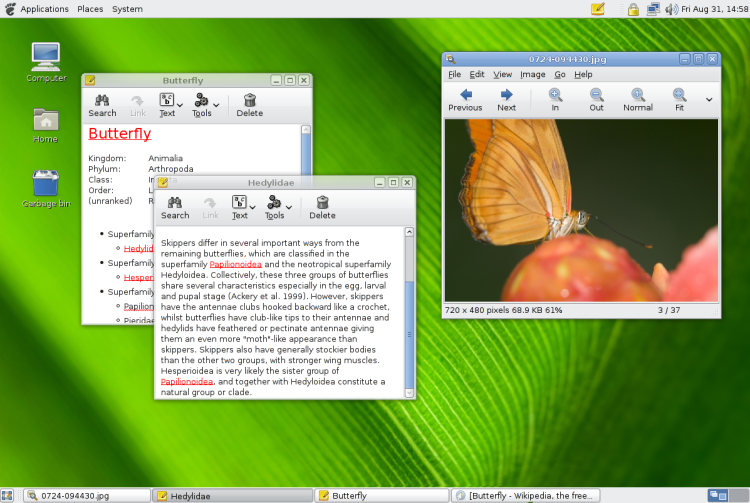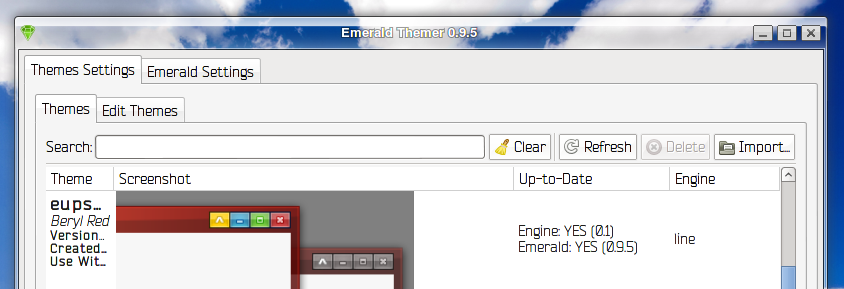|
Xgl
Xgl is an obsolete display server implementation supporting the X Window System protocol designed to take advantage of modern graphics cards via their OpenGL drivers, layered on top of OpenGL. It supports hardware acceleration of all X, OpenGL and XVideo applications and graphical effects by a compositing window manager such as Compiz or Beryl. The project was started by David Reveman of Novell and first released on January 2, 2006. It was removed from the X.org server in favor of AIGLX on June 12, 2008. History Development of Xgl started in 2004. Until its release in 2006 it was developed in the open on public mailing lists, though during the last few months development of Xgl was private. On that day the source to Xgl was re-opened to the public, and included in freedesktop.org, along with major restructuring to allow a wider range of supported display drivers. X server backends used by Xgl include Xglx and Xegl. In February 2006 the server gained wide publicity after a pub ... [...More Info...] [...Related Items...] OR: [Wikipedia] [Google] [Baidu] |
AIGLX
Accelerated Indirect GLX ("AIGLX") is an Open-source software, open source project founded by Red Hat and the Fedora (operating system), Fedora community, led by Kristian Høgsberg, to allow accelerated indirect GLX rendering capabilities to the X.Org Server and Direct Rendering Infrastructure, DRI drivers. This allows remote X clients to get fully hardware accelerated rendering over the GLX protocol; coincidentally, this development was required for OpenGL compositing window managers to function with hardware acceleration. Rationale There are two ways in which a windowing system can allow an OpenGL implementation to talk to the graphics card. The first is to specify the OpenGL command stream in a portable network-neutral manner using a client/server implementation similar to the X11 drawing routines. This method, used by AIGLX, is indirect in that the drawing commands are sent to the X server and then the X server sends them along to the graphics card. The second way, whi ... [...More Info...] [...Related Items...] OR: [Wikipedia] [Google] [Baidu] |
Compositing Window Manager
A compositing window manager, or compositor, is a window manager that provides applications with an off-screen data buffer, buffer for each window. The window manager Compositing, composites the window buffers into an image representing the screen and writes the result into the display memory. Compositing window managers may perform additional processing on buffered windows, applying 2D computer graphics, 2D and 3D computer graphics, 3D animated effects such as Alpha blending, blending, Dissolve (filmmaking), fading, Image scaling, scaling, Rotation (mathematics), rotation, Multi-monitor#Clone mode, duplication, bending and contortion, shuffling, Gaussian blur, blurring, redirecting applications, and Translation (geometry), translating windows into one of a number of Display device, displays and virtual desktops. Computer graphics technology allows for visual effects to be rendered in real time such as drop shadows, live previews, and complex animation. Since the screen is Double b ... [...More Info...] [...Related Items...] OR: [Wikipedia] [Google] [Baidu] |
Compiz
Compiz () is a compositing window manager for the X Window System, using 3D graphics hardware to create fast compositing desktop effects for window management. Effects, such as a minimization animation or a cube workspace, are implemented as loadable plugins. Because it conforms to the ICCCM conventions, Compiz can be used as a substitute for the default Mutter or Metacity, when using GNOME Panel, or KWin in KDE Plasma Workspaces. Internally Compiz uses the OpenGL library as the interface to the graphics hardware. Hardware requirements Initially, Compiz only worked with 3D hardware supported by Xgl. Most NVIDIA and ATI graphics cards are known to work with Compiz on Xgl. Since May 22, 2006 Compiz works on the standard X.Org Server, by using AIGLX. Besides Intel GMA graphics cards, AIGLX also supports using AMD graphics cards (including R300 and newer cards) using the open-source driver which supports since fall 2006. NVIDIA's binary drivers (since Version 1.0-9629) support ... [...More Info...] [...Related Items...] OR: [Wikipedia] [Google] [Baidu] |
David Reveman
Compiz () is a compositing window manager for the X Window System, using 3D graphics hardware to create fast compositing desktop effects for window management. Effects, such as a minimization animation or a cube workspace, are implemented as loadable plugins. Because it conforms to the ICCCM conventions, Compiz can be used as a substitute for the default Mutter or Metacity, when using GNOME Panel, or KWin in KDE Plasma Workspaces. Internally Compiz uses the OpenGL library as the interface to the graphics hardware. Hardware requirements Initially, Compiz only worked with 3D hardware supported by Xgl. Most NVIDIA and ATI graphics cards are known to work with Compiz on Xgl. Since May 22, 2006 Compiz works on the standard X.Org Server, by using AIGLX. Besides Intel GMA graphics cards, AIGLX also supports using AMD graphics cards (including R300 and newer cards) using the open-source driver which supports since fall 2006. NVIDIA's binary drivers (since Version 1.0-9629) support ... [...More Info...] [...Related Items...] OR: [Wikipedia] [Google] [Baidu] |
Beryl (window Manager)
Compiz () is a compositing window manager for the X Window System, using 3D graphics hardware to create fast compositing desktop effects for window management. Effects, such as a minimization animation or a cube workspace, are implemented as loadable plugins. Because it conforms to the ICCCM conventions, Compiz can be used as a substitute for the default Mutter or Metacity, when using GNOME Panel, or KWin in KDE Plasma Workspaces. Internally Compiz uses the OpenGL library as the interface to the graphics hardware. Hardware requirements Initially, Compiz only worked with 3D hardware supported by Xgl. Most NVIDIA and ATI graphics cards are known to work with Compiz on Xgl. Since May 22, 2006 Compiz works on the standard X.Org Server, by using AIGLX. Besides Intel GMA graphics cards, AIGLX also supports using AMD graphics cards (including R300 and newer cards) using the open-source driver which supports since fall 2006. NVIDIA's binary drivers (since Version 1.0-9629) support ... [...More Info...] [...Related Items...] OR: [Wikipedia] [Google] [Baidu] |
Compiz Fusion
Compiz () is a compositing window manager for the X Window System, using 3D graphics hardware to create fast compositing desktop effects for window management. Effects, such as a minimization animation or a cube workspace, are implemented as loadable plugins. Because it conforms to the ICCCM conventions, Compiz can be used as a substitute for the default Mutter or Metacity, when using GNOME Panel, or KWin in KDE Plasma Workspaces. Internally Compiz uses the OpenGL library as the interface to the graphics hardware. Hardware requirements Initially, Compiz only worked with 3D hardware supported by Xgl. Most NVIDIA and ATI graphics cards are known to work with Compiz on Xgl. Since May 22, 2006 Compiz works on the standard X.Org Server, by using AIGLX. Besides Intel GMA graphics cards, AIGLX also supports using AMD graphics cards (including R300 and newer cards) using the open-source driver which supports since fall 2006. NVIDIA's binary drivers (since Version 1.0-9629) support ... [...More Info...] [...Related Items...] OR: [Wikipedia] [Google] [Baidu] |
X Window System
The X Window System (X11, or simply X) is a windowing system for bitmap displays, common on Unix-like operating systems. X provides the basic framework for a GUI environment: drawing and moving windows on the display device and interacting with a mouse and keyboard. X does not mandate the user interfacethis is handled by individual programs. As such, the visual styling of X-based environments varies greatly; different programs may present radically different interfaces. X originated as part of Project Athena at Massachusetts Institute of Technology (MIT) in 1984. The X protocol has been at version 11 (hence "X11") since September 1987. The X.Org Foundation leads the X project, with the current reference implementation, X.Org Server, available as free and open-source software under the MIT License and similar permissive licenses. Purpose and abilities X is an architecture-independent system for remote graphical user interfaces and input device capabilities. Each person using a ... [...More Info...] [...Related Items...] OR: [Wikipedia] [Google] [Baidu] |
Novell
Novell, Inc. was an American software and services company headquartered in Provo, Utah, that existed from 1980 until 2014. Its most significant product was the multi-platform network operating system known as Novell NetWare. Under the leadership of chief executive Ray Noorda, NetWare became the dominant form of personal computer networking during the second half of the 1980s and first half of the 1990s. At its high point, NetWare had a 63 percent share of the market for network operating systems and by the early 1990s there were over half a million NetWare-based networks installed worldwide encompassing more than 50 million users. Novell technology contributed to the emergence of local area networks, which displaced the dominant mainframe computing model and changed computing worldwide. Novell was the second-largest maker of software for personal computers, trailing only Microsoft Corporation, and became instrumental in making Utah Valley a focus for technology and software ... [...More Info...] [...Related Items...] OR: [Wikipedia] [Google] [Baidu] |
XVideo
The X video extension, often abbreviated as XVideo or Xv, is a video output mechanism for the X Window System. The protocol was designed by David Carver; the specification for version 2 of the protocol was written in July 1991. It is mainly used today to resize video content in the video controller hardware in order to enlarge a given video or to watch it in full screen mode. Without XVideo, X would have to do this scaling on the main CPU. That requires a considerable amount of processing power, which could slow down or degrade the video stream; video controllers are specifically designed for this kind of computation, so can do it much more cheaply. Similarly, the X video extension can have the video controller perform color space conversions, and change the contrast, brightness, and hue of a displayed video stream. In order for this to work, three things have to come together: * The video controller has to provide the required functions. * The device driver software for the v ... [...More Info...] [...Related Items...] OR: [Wikipedia] [Google] [Baidu] |
Hardware Acceleration
Hardware acceleration is the use of computer hardware designed to perform specific functions more efficiently when compared to software running on a general-purpose central processing unit (CPU). Any transformation of data that can be calculated in software running on a generic CPU can also be calculated in custom-made hardware, or in some mix of both. To perform computing tasks more quickly (or better in some other way), generally one can invest time and money in improving the software, improving the hardware, or both. There are various approaches with advantages and disadvantages in terms of decreased latency, increased throughput and reduced energy consumption. Typical advantages of focusing on software may include more rapid development, lower non-recurring engineering costs, heightened portability, and ease of updating features or patching bugs, at the cost of overhead to compute general operations. Advantages of focusing on hardware may include speedup, reduced pow ... [...More Info...] [...Related Items...] OR: [Wikipedia] [Google] [Baidu] |
Direct Rendering Infrastructure
The Direct Rendering Infrastructure (DRI) is the framework comprising the modern Linux graphics stack which allows unprivileged user-space programs to issue commands to graphics hardware without conflicting with other programs. The main use of DRI is to provide hardware acceleration for the Mesa implementation of OpenGL. DRI has also been adapted to provide OpenGL acceleration on a framebuffer console without a display server running. DRI implementation is scattered through the X Server and its associated client libraries, Mesa 3D and the Direct Rendering Manager kernel subsystem. All of its source code is free software. Overview In the classic X Window System architecture the X Server is the only process with exclusive access to the graphics hardware, and therefore the one which does the actual rendering on the framebuffer. All that X clients do is communicate with the X Server to dispatch rendering commands. Those commands are hardware independent, meaning that the ... [...More Info...] [...Related Items...] OR: [Wikipedia] [Google] [Baidu] |
OpenCroquet
Croquet OS is a web-based operating system for creating three-dimensional apps with multi-user functionalities that run simultaneously on any device. Croquet can be used for communication, online gaming environments such as massively multiplayer online role-playing games (MMORPGs), 3D wikis, virtual learning and problem solving environments, privately maintained or interconnected multi-user virtual environments, and more advanced functions such as highly scalable collaborative data visualization, resource sharing, and synchronous computation among multiple users. History The original authors of Croquet opened a commercial company named Qwaq which was later renamed to Teleplace. That technology was later sold back to a group of the original Croquet developers and became Immersive Terf. Croquet is the confluence of several independent lines of work that were being carried out by its six principal architects, Alan Kay, David A. Smith. David P. Reed, Andreas Raab, Julian ... [...More Info...] [...Related Items...] OR: [Wikipedia] [Google] [Baidu] |





